|

Yellin's gallery
sells pieces from
the kilns of Japan's
finest potters
|
|
|
Four Ceramists Showing in Tokyo in June 2001
|
Click image to jump to exhibition
|
|
|
|
|
|
|
|
|
This past weekend I left the semi-rural area of Numazu and caught a bullet train - shinkansen - up to the Big Dango of Tokyo. The purpose was the third sake-pottery seminar of the year hosted by sake expert John Gauntner (www.sake-world.com) and myself. We had a packed house and John spoke on the lively sake known as yamahai and I introduced the term yakishime (those who signed up for the e-y net newsletter will be getting more details on this seminar - along with two mystical poems).
Before the talk and the following day I took in a few exhibitions:
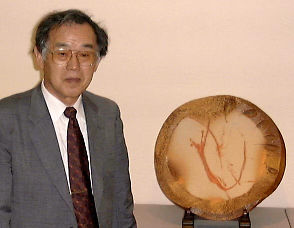 Jun Isezaki at Jun Isezaki at
Nihonbashi
Mitsukoshi:
Mori, Kimura, Kaneshige and add the names of Yamamoto and Isezaki as Bizen potting dynasties. Both the latter members don't go back in history as long as the first three but they are on the road to creating a long future. The most famous, Yamamoto, is of course Toshu (1906-1994), Bizen's third Living National Treasure. His sons Yuichi, Izuru, and Atsuo, and grandson Ryuichi, are also potters.
Jun Isezaki is the second son of Isezaki Yozan (1902-1961), one of the greatest Bizen saikumono (ornamental figures ) potters ever. His elder brother is Mitsuru, whose four sons are also potters - whew. Jun's son Koichiro is following in his footsteps as well. The Isezaki's and Yamamoto's should be added to the 'Six Families of Bizen.'
Jun's exhibition had him showing his very orthodox and traditional tea forms as well as his sculptural works.
Most of the time it's his wonderful firings that save his Momoyama-period inspired shapes from becoming boring - yet each piece does draw the viewer in. His sculptural forms, some on highly cut legs, seem to be overly paying homage to his star pupil, Kakurezaki Ryuichi. At times the similarities were just too glaring.
His black-slipped wares, like this large plate with hidasuki marking in the center, were fantastic.
All the wares were fired in an anagama. I don't know how Isezaki can find the time to work, he's so busy as a teacher, on various art committees, and working on a secret project that he made me promise not to tell anyone until after it's completed. O-tanoshimi-ni.
For more on Isezaki Jun, please read my Japan Times (2001) article. Also, Isezaki Jun was named a Living National Treasure in 2004. Click here for story about Isezaki's LNT award
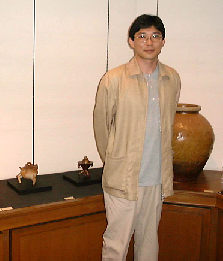 Suehiro Manabu Suehiro Manabu
at Shibuya Kuroda Toen:
Suehiro (1966 -) is part of the younger generation of popular Bizen potters and first learned the art from Bizen giant Mori Togaku. Suehiro was at Mori's side for about ten years helping to build Mori's huge kilns and all the processes in between. He made his own kiln nearby Mori's and it's a similar anagama. He uses the same type clay and is exploring his own voice in the time honored Bizen tradition.
The theme of this exhibition was koro or incense burners. Suehiro showed his vivid imagination in the works creating koro that at times resembled old bronzes (below photo), UFO's (below) and pieced together planks (below).
He gets a rich firing that has soft and lovely tobi-goma (flying sesame), burgundy red clay bodies and light tsuchi-aji.
I always enjoy Suehiro's exhibitions and look forward to watching him continue to challenge his spirit and clay.
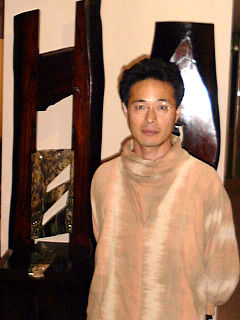 Tsukamoto Haruhiko Tsukamoto Haruhiko
at Tobu:
Another relatively young potter that has found a following is Gifu-based Tsukamoto Haruhiko (1959 -). He knew he wanted to be a potter when he was in high school; his school was near many kilns. What sets him apart from other Mino contemporaries is the deep green of his Oribe glaze matched with his rugged forms (see photo below). Even his plates have chunky lines etched in the surface (below).
The hues change from light summer bamboo to opaque emerald. The shokki or tablewares worked best, with a few chawan calling me to be used (below). His Shino chawan were nice (below) and rich but a bit heavy.
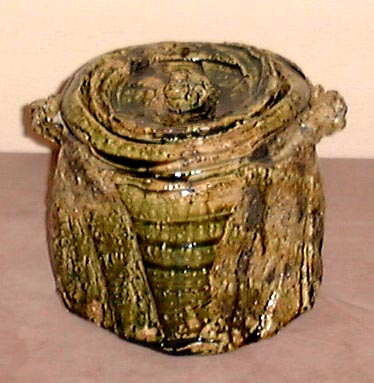 |
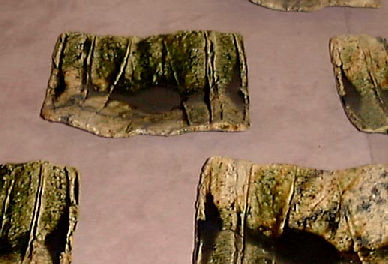 |
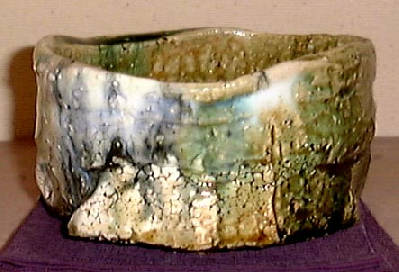 |
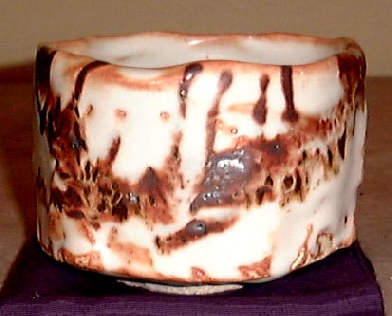 |
He needs to work on his nezumi Shino a bit more and also try not to have some vases call the forms of Okabe and Kakurezaki so loudly. Yet, as with most grand traditions in the orient, an artist first imitates, masters, and forgets. Tsukamoto is well into the second phase and should find himself sitting in his own king-sized Oribe chair in the future.
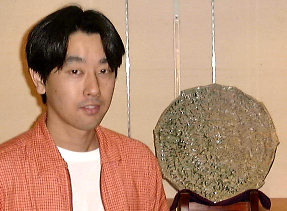 Kako Katsumi Kako Katsumi
at Tobu:
Make a wrong turn, make a new discovery. Go to view one thing and have your eye caught by another. Such was my 'discovery' of the late twenty (?) something Kako. He was showing in a little, tiny corner of the large Tobu gallery that was featuring Tsukamoto's work. What I liked about Kako's work was the green ash-glaze that brought to mind my favorite green ash-glazed potter of all time, Ezaki Issei. Also, his forms were not overly trying to capture something beyond his years.
 |
They were natural and true to his spirit. Some worked better than others though. His chawan were comfortable but his pouring vessels were a little clunky.
He also needs to work on his mizusashi. On the positive side again, though, he got some nice blues with his kohiki glaze that worked nicely on his shokki. He works out of Hyogo Prefecture. For more on Kako Katsumi, please visit:
|
|
|